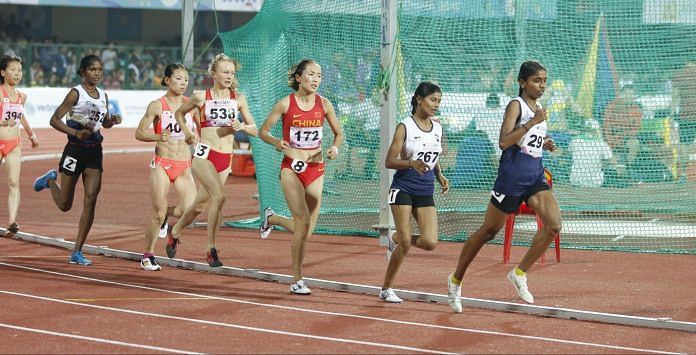The recent spate of positive dope tests by athletes is not just a reflection of NDTL’s quality, but also NADA’s failure to implement its policies effectively.
New Delhi: Last Monday, sprinter Sanjeet Singh became possibly the first Indian sportsperson to test positive for the drugs Ostarine and GW1516. Ostarine, a drug developed for the treatment of muscle wasting and osteoporosis, was banned by the World Anti-Doping Agency in 2008. It can produce effects similar to those of anabolic steroids, in that it also creates artificial testosterone in the body.
Singh was tested at the Services Championships in Bengaluru on 19 September, soon after posting his personal best in both 100m and 200m sprints — a national-record equalling 10.26 seconds and 20.96 seconds respectively. He had also won the double at the Open National Championships in Bhubaneswar that month.
But his is not an isolated case of doping. Just the previous week, five other track-and-field athletes were found to be dope-positive by a WADA-accredited lab in Montreal, Canada.
These athletes — Asian Games 400m champion Nirmala Sheoran, shot-putter Naveen Chikara, middle-distance runners Jhuma Khatun and Sanjivani Jadhav, and discus thrower Sandeep Kumari — had previously tested negative at India’s own National Dope Testing Laboratory (NDTL).
The Athletics Federation of India, headed by former sprinter Adille Sumariwalla, has been quick to impose four-year bans on the dope-positive athletes.
At the moment story is over as far as AFI is concerned. 4 year ban imposed. Now it’s up to the athlete to challenge it at various fora. AFI has no role to play. And to my information some of the guilty have accepted guilt and not to even gone for B sample testing.
— Adille Sumariwalla OLY (@Adille1) November 28, 2018
But the growing number of cases has raised questions over the quality and frequency of dope testing in India.
The anti-doping mechanism in India
Soon after the five athletes tested positive, National Anti-Doping Agency (NADA) director-general Navin Agrawal ordered a probe into the NDTL’s “lapses”. But this also raised questions of jurisdiction, since NADA and NDTL are disparate bodies functioning under the Union Ministry of Youth Affairs and Sports, even though the NADA D-G is an ex-officio member of the governing body of NDTL.
NADA’s job is to implement anti-doping rules as per the WADA code, regulate dope control programmes, and promote education and create awareness about doping.
NDTL, on the other hand, is a testing and research laboratory, whose mandate is to be “an autonomous body free of any anti-doping agencies”. It was granted WADA accreditation in 2010, but that status is now under threat due to repeat instances of athletes cleared by NDTL failing dope tests elsewhere.
Also read: How does Haryana top India’s medal tallies? The answer lies in history and incentives
Charges against NDTL
NADA D-G Agrawal told ThePrint that “just because the NDTL is an autonomous body does not mean it is free to do whatever it thinks is suitable”.
“They haven’t been doing their job properly,” he said, and added that the NDTL needed to update its equipment and amp up its testing laboratories.
This is not the first time NDTL’s credibility is being questioned. Chandresh Narayanan, cricket writer and former media officer with the game’s international governing body, the ICC, pointed out that “the BCCI has never trusted NADA and NDTL because of their bureaucratic style of working”.
“Indian cricketers are tested only in WADA-accredited labs elsewhere,” he said.
However, Dr P.L. Sahu, the scientific director of NDTL, responded to this criticism by telling ThePrint: “We are a testing laboratory and we are only doing our job. If they (NADA) want to impose an inquiry, they are free to do so.”
Also read: Sugar and spice, and not so nice: An arrogant Virat Kohli is great news for Indian cricket
What has NADA been up to?
But has NADA done its job? Nirmala Sheoran is a case in point: Senior sports journalist K.P. Mohan, an authoritative voice on athletics and on doping in India, wrote recently in an article that she had been running away from dope tests for years, and NADA had failed to rein her in.
“NADA tested Nirmala at the Guwahati inter-state on June 29. There was not a single out-of-competition test on her up to July-end by NADA. Even when reports appeared about her ‘disappearing’ acts, NADA did not deem it necessary to test her when she joined the camp in the Czech Republic. Between Nov 2017 and May 2018, Nirmala was in the NADA RTP (registered testing pool) before being dropped. It is doubtful whether it tested her out-of-competition even once during this period.”
Gurbachan Singh Randhawa, the 1962 Asian Games gold medallist in decathlon, pointed out that NADA had taken India from No.3 in WADA’s rankings of top doping nations in the world to No.6. But while this might be a step in the right direction, Randhawa said: “The ranking has improved but the number of tests happening at institutional level has dropped. They have reduced testing in order to hide the number of athletes doping.”
Randhawa put the blame for this current spate of failed dope tests squarely on NADA.
“It is not that the athletes these days do not have knowledge of performance enhancing drugs, they have knowledge and access to everything. But like a bad parent, NADA is unable to impose checks and control over those exploiting unfair means,” he said.



